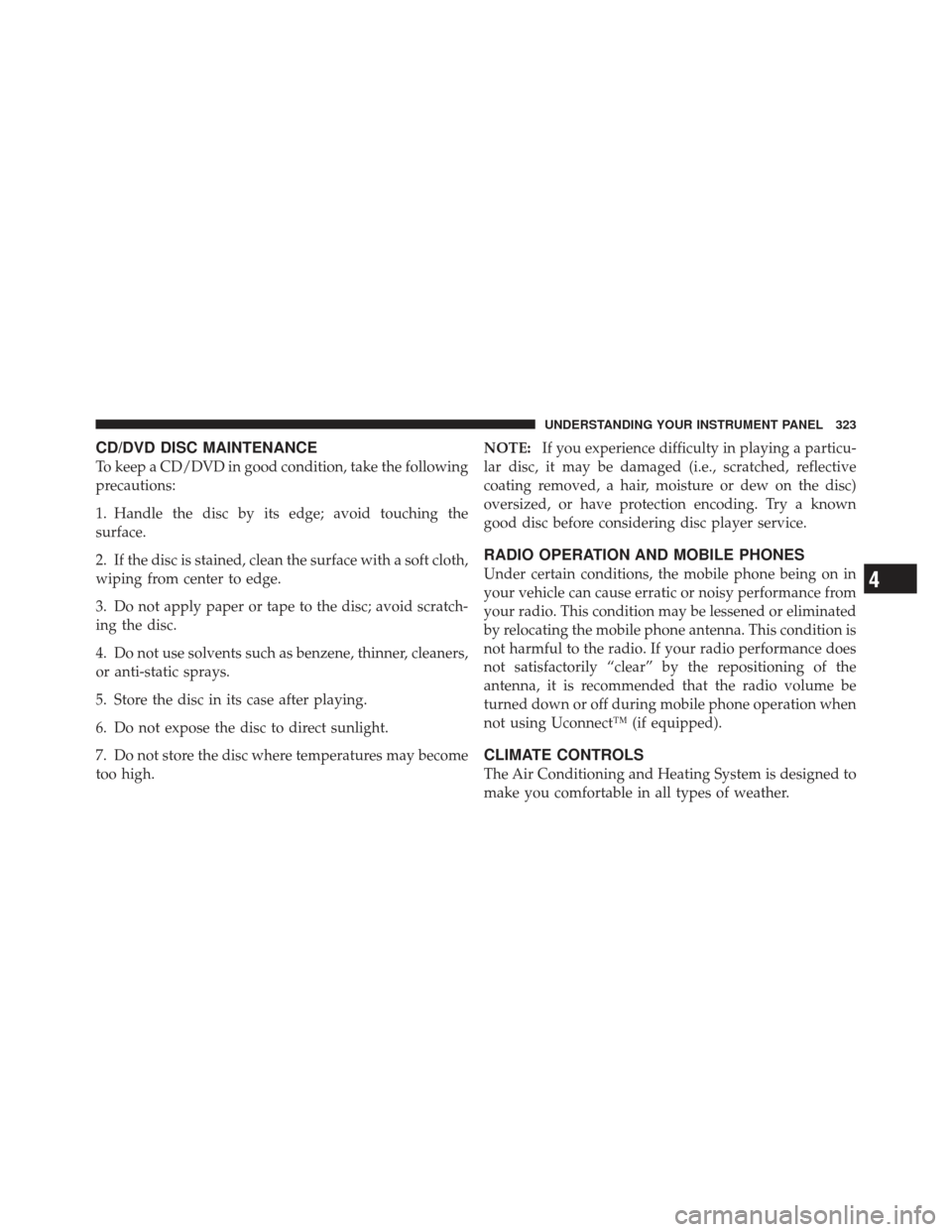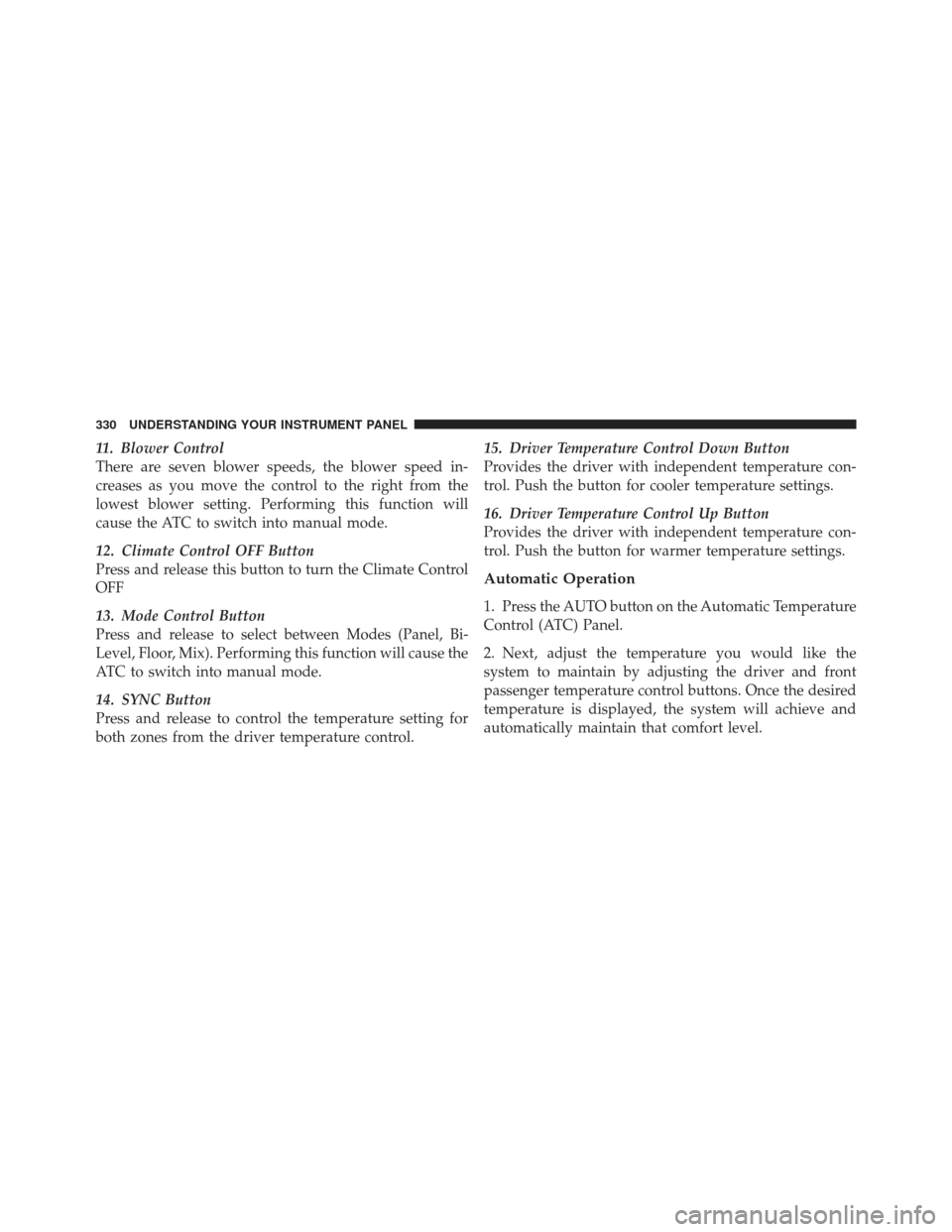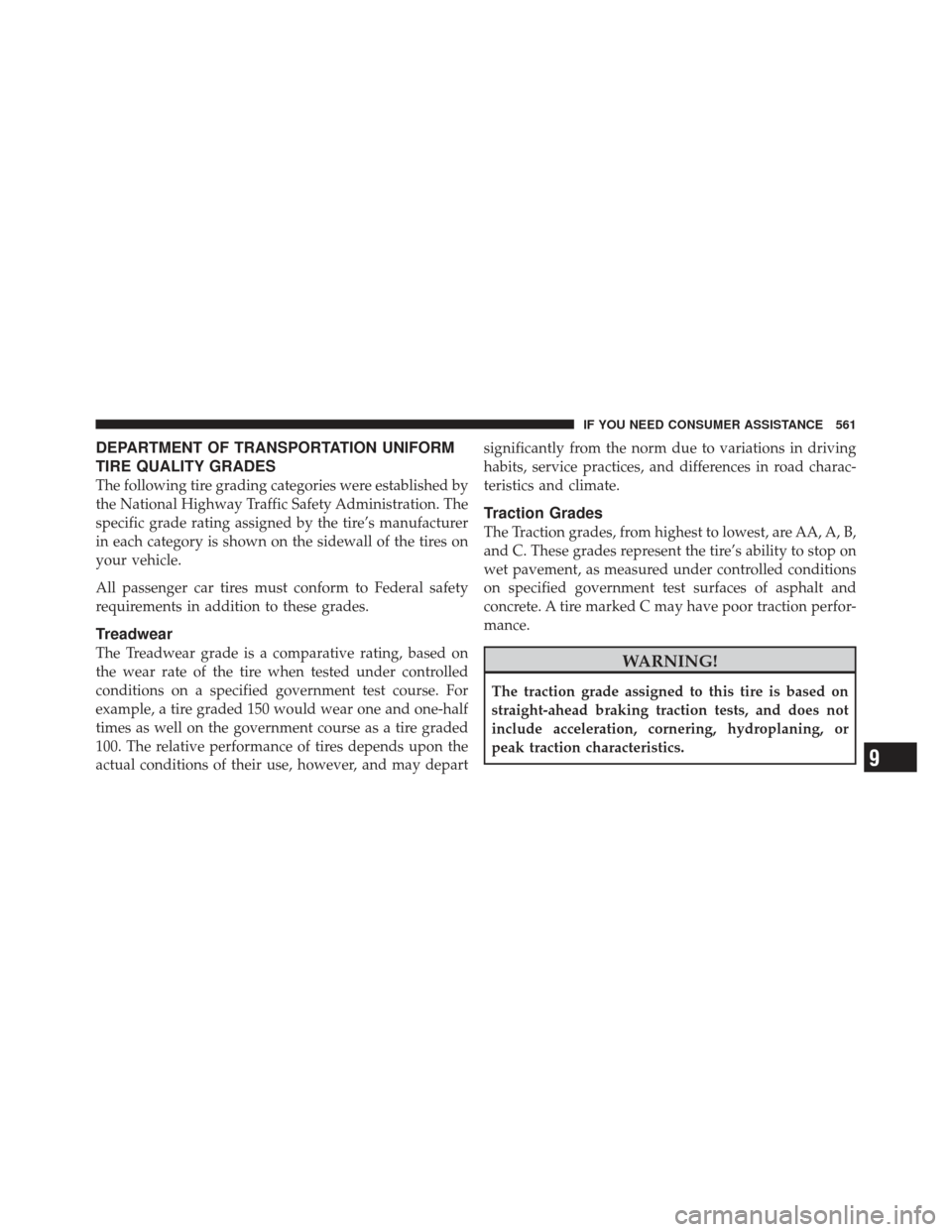Page 248 of 587
INSTRUMENT PANEL FEATURES
1 — Air Outlet6 — Lower Switch Bank11 — Hood Release
2 — Instrument Cluster 7 — Hazard Switch12 — Fuel Door Release
3 — Radio 8 — Storage Bin13 — Headlight Switch
4 — Glove Compartment 9 — ESC Button14 – Dimmer Control
5 — Climate Controls 10 — Ignition Switch
246 UNDERSTANDING YOUR INSTRUMENT PANEL
Page 252 of 587

5. TOW/HAUL Indicator Light — If EquippedThis light will illuminate when the TOW/
HAUL button has been selected. The TOW/
HAUL button is located in the center of the
instrument panel (below the climate controls).
6. Turn Signal Indicator The arrows will flash with the exterior turn signals
when the turn signal lever is operated. A tone will
chime, and an EVIC message will appear if the turn
signals are left on for more than 1 mile (1.6 km).
7. High Beam Indicator Indicates that headlights are on high beam.
8. Front Fog Light Indicator — If Equipped This indicator will illuminate when the front fog
lights are on. 9. Hill Descent Control Indicator Light — If Equipped
The symbol indicates the status of the Hill
Decent Control (HDC) feature. The lamp will
be on solid when HDC is armed. HDC can only
be armed when the transfer case is in the “4WD
Low” position and the vehicle speed is less then 30 mph
(48 km/h). If these conditions are not met while attempt-
ing to use the HDC feature, the HDC indicator lamp will
flash on/off.
10. Electronic Vehicle Information Center (EVIC)
Display/Odometer Display
The odometer display shows the total distance the ve-
hicle has been driven.
U.S. Federal regulations require that upon transfer of
vehicle ownership, the seller certify to the purchaser the
correct mileage that the vehicle has been driven. If your
odometer needs to be repaired or serviced, the repair
technician should leave the odometer reading the same
250 UNDERSTANDING YOUR INSTRUMENT PANEL
Page 325 of 587

CD/DVD DISC MAINTENANCE
To keep a CD/DVD in good condition, take the following
precautions:
1. Handle the disc by its edge; avoid touching the
surface.
2. If the disc is stained, clean the surface with a soft cloth,
wiping from center to edge.
3. Do not apply paper or tape to the disc; avoid scratch-
ing the disc.
4. Do not use solvents such as benzene, thinner, cleaners,
or anti-static sprays.
5. Store the disc in its case after playing.
6. Do not expose the disc to direct sunlight.
7. Do not store the disc where temperatures may become
too high.NOTE:
If you experience difficulty in playing a particu-
lar disc, it may be damaged (i.e., scratched, reflective
coating removed, a hair, moisture or dew on the disc)
oversized, or have protection encoding. Try a known
good disc before considering disc player service.
RADIO OPERATION AND MOBILE PHONES
Under certain conditions, the mobile phone being on in
your vehicle can cause erratic or noisy performance from
your radio. This condition may be lessened or eliminated
by relocating the mobile phone antenna. This condition is
not harmful to the radio. If your radio performance does
not satisfactorily “clear” by the repositioning of the
antenna, it is recommended that the radio volume be
turned down or off during mobile phone operation when
not using Uconnect™ (if equipped).
CLIMATE CONTROLS
The Air Conditioning and Heating System is designed to
make you comfortable in all types of weather.
4
UNDERSTANDING YOUR INSTRUMENT PANEL 323
Page 326 of 587
Dual-Zone Manual Heating and Air Conditioning
The Dual-Zone Manual Climate Controls allow both
driver and front passenger seat occupants to select indi-
vidual comfort settings. The controls consist of a series of
outer rotary dials and inner push knobs.
Blower Control
Rotate this control to regulate the
amount of air forced through the ven-
tilation system in any mode. The
blower speed increases as you move
the control to the right from the “O”
(OFF) position. There are seven blower
speeds.
Temperature Controls
•
Driver Temperature ControlRotate this control to regulate the tem-
perature of the air inside the passenger
compartment for the left front seat
occupant. Rotating the dial left into
the blue area of the scale indicates
cooler temperatures while rotating
right into the red area indicates
warmer temperatures.
324 UNDERSTANDING YOUR INSTRUMENT PANEL
Page 332 of 587

11. Blower Control
There are seven blower speeds, the blower speed in-
creases as you move the control to the right from the
lowest blower setting. Performing this function will
cause the ATC to switch into manual mode.
12. Climate Control OFF Button
Press and release this button to turn the Climate Control
OFF
13. Mode Control Button
Press and release to select between Modes (Panel, Bi-
Level, Floor, Mix). Performing this function will cause the
ATC to switch into manual mode.
14. SYNC Button
Press and release to control the temperature setting for
both zones from the driver temperature control.15. Driver Temperature Control Down Button
Provides the driver with independent temperature con-
trol. Push the button for cooler temperature settings.
16. Driver Temperature Control Up Button
Provides the driver with independent temperature con-
trol. Push the button for warmer temperature settings.
Automatic Operation
1. Press the AUTO button on the Automatic Temperature
Control (ATC) Panel.
2. Next, adjust the temperature you would like the
system to maintain by adjusting the driver and front
passenger temperature control buttons. Once the desired
temperature is displayed, the system will achieve and
automatically maintain that comfort level.
330 UNDERSTANDING YOUR INSTRUMENT PANEL
Page 464 of 587

HAZARD WARNING FLASHERS
The Hazard Warning flasher switch is located on the
switch bank just above the climate controls.Press the switch to turn on the Hazard Warning
flasher. When the switch is activated, all directional
turn signals will flash on and off to warn oncoming
traffic of an emergency. Press the switch a second time to
turn off the Hazard Warning flashers.
This is an emergency warning system and it should not
be used when the vehicle is in motion. Use it when your
vehicle is disabled and it is creating a safety hazard for
other motorists.
When you must leave the vehicle to seek assistance, the
Hazard Warning flashers will continue to operate even
though the ignition is placed in the OFF position.
NOTE: With extended use the Hazard Warning flashers
may wear down your battery.
IF YOUR ENGINE OVERHEATS
In any of the following situations, you can reduce the
potential for overheating by taking the appropriate ac-
tion.
•On the highways — slow down.
•In city traffic — while stopped, place the transmission
in NEUTRAL, but do not increase the engine idle
speed.
NOTE: There are steps that you can take to slow down
an impending overheat condition:
•If your air conditioner (A/C) is on, turn it off. The A/C
system adds heat to the engine cooling system and
turning the A/C off can help remove this heat.
462 WHAT TO DO IN EMERGENCIES
Page 526 of 587
Cavity CartridgeFuseMini
Fuse Description
M26 10 Amp RedDriver Door Switch
Bank
M27 10 Amp RedIgnition Switch/
Wireless Control
Module/Keyless Entry
Module
M28 15 Amp BluePowertrain Controller/
Transmission Control-
ler
M29 10 Amp RedTire Pressure Monitor
M30 15 Amp BlueJ1962 Diag Connector
M31 20 Amp YellowBackup Lamps
M32 10 Amp RedOccupant Restraint
ControllerCavity Cartridge
FuseMini
Fuse Description
M33 10 Amp RedPowertrain Controller/
Transmission Control-
ler
M34 10 Amp RedPark Assist Module/
Climate Control Sys-
tem Module/Infra Red
Sensor/Compass Mod-
ule
M35 15 Amp BlueLeft Rear Parklamps
M36 20 Amp YellowPower Outlet
M37 10 Amp RedAntilock Brakes/
Stability Control Sys-
tem Module
M38 25 Amp NaturalAll Door Lock &Un-
lock
524 MAINTAINING YOUR VEHICLE
Page 563 of 587

DEPARTMENT OF TRANSPORTATION UNIFORM
TIRE QUALITY GRADES
The following tire grading categories were established by
the National Highway Traffic Safety Administration. The
specific grade rating assigned by the tire’s manufacturer
in each category is shown on the sidewall of the tires on
your vehicle.
All passenger car tires must conform to Federal safety
requirements in addition to these grades.
Treadwear
The Treadwear grade is a comparative rating, based on
the wear rate of the tire when tested under controlled
conditions on a specified government test course. For
example, a tire graded 150 would wear one and one-half
times as well on the government course as a tire graded
100. The relative performance of tires depends upon the
actual conditions of their use, however, and may departsignificantly from the norm due to variations in driving
habits, service practices, and differences in road charac-
teristics and climate.
Traction Grades
The Traction grades, from highest to lowest, are AA, A, B,
and C. These grades represent the tire’s ability to stop on
wet pavement, as measured under controlled conditions
on specified government test surfaces of asphalt and
concrete. A tire marked C may have poor traction perfor-
mance.
WARNING!
The traction grade assigned to this tire is based on
straight-ahead braking traction tests, and does not
include acceleration, cornering, hydroplaning, or
peak traction characteristics.
9
IF YOU NEED CONSUMER ASSISTANCE 561